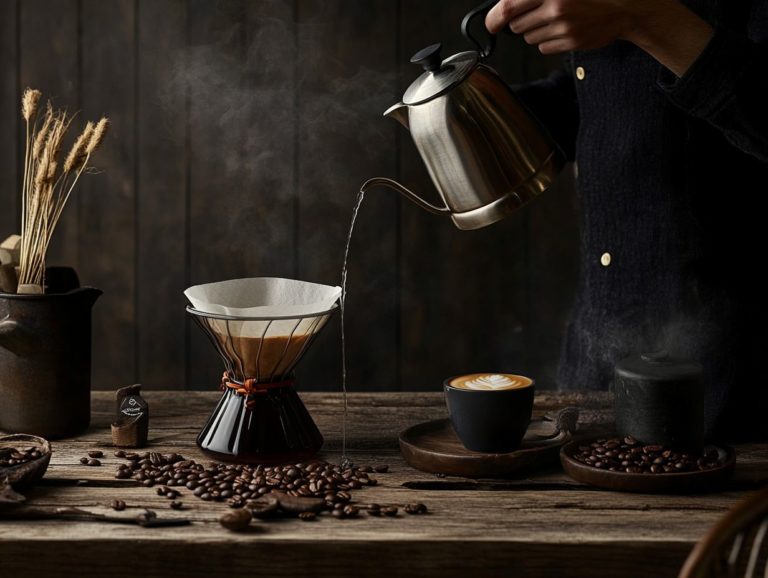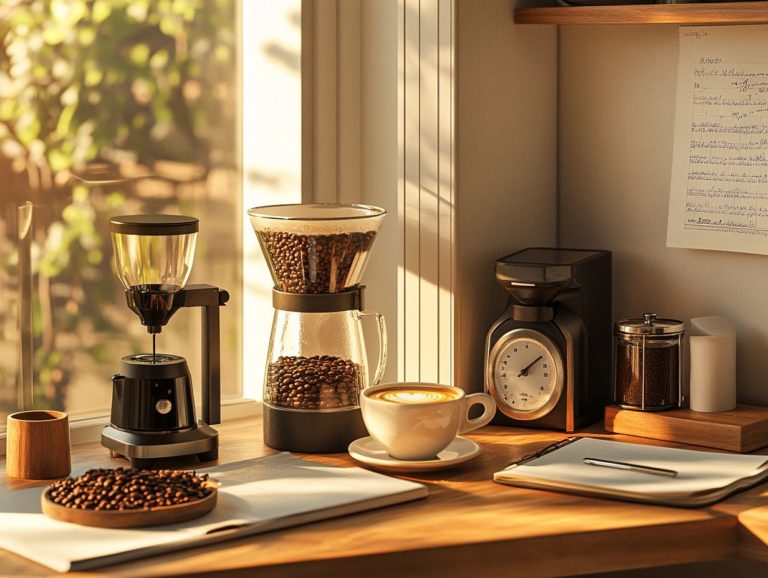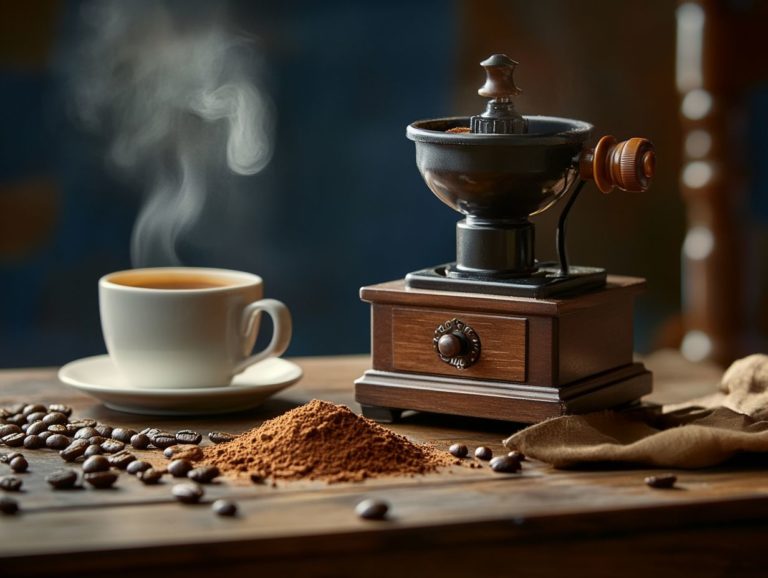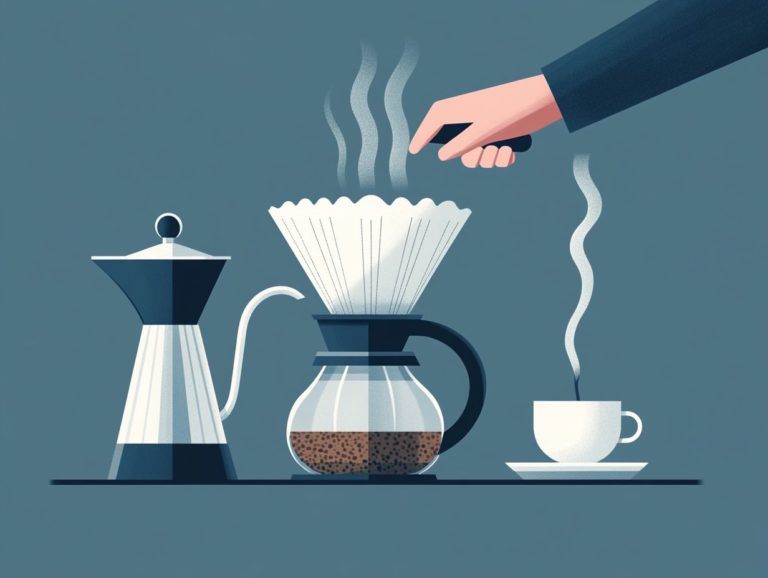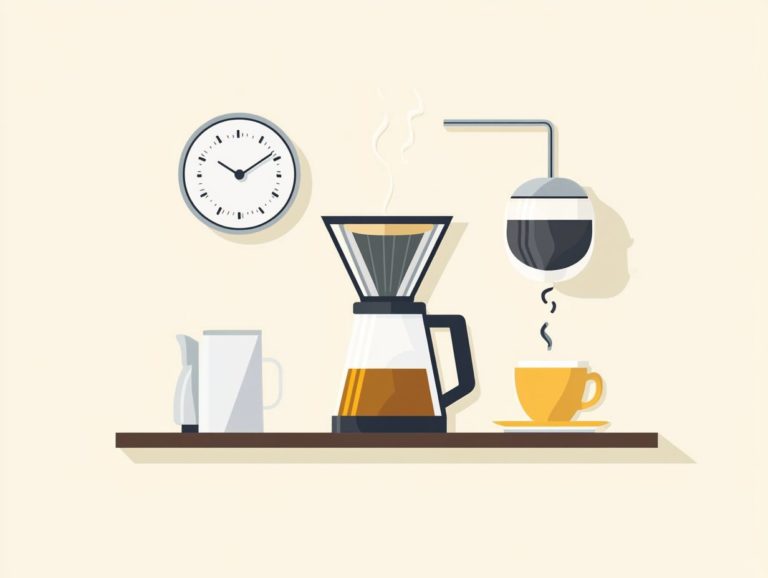The Best Brewing Techniques for Cold Coffee
Cold coffee is a refreshing delight that presents itself in various forms, each boasting its own unique brewing techniques and flavor profile. Whether you find yourself craving the smooth richness of cold brew, the sharp invigorating kick of iced coffee, or the innovative allure of nitro cold brew, there s a method tailored to your palate. From immersion brewing to the Japanese method, the array of cold coffee techniques offers a rich coffee experience for all coffee lovers.
This article delves into five popular brewing techniques for cold coffee, illuminating their pros and cons while providing insights on which method might best align with your taste and lifestyle. Each method, whether it’s cold brew, iced coffee, or Japanese iced coffee, brings a unique approach to coffee preparation.
Dive into your coffee curiosity today and discover the ultimate way to savor this chilled beverage!
Contents
Key Takeaways:
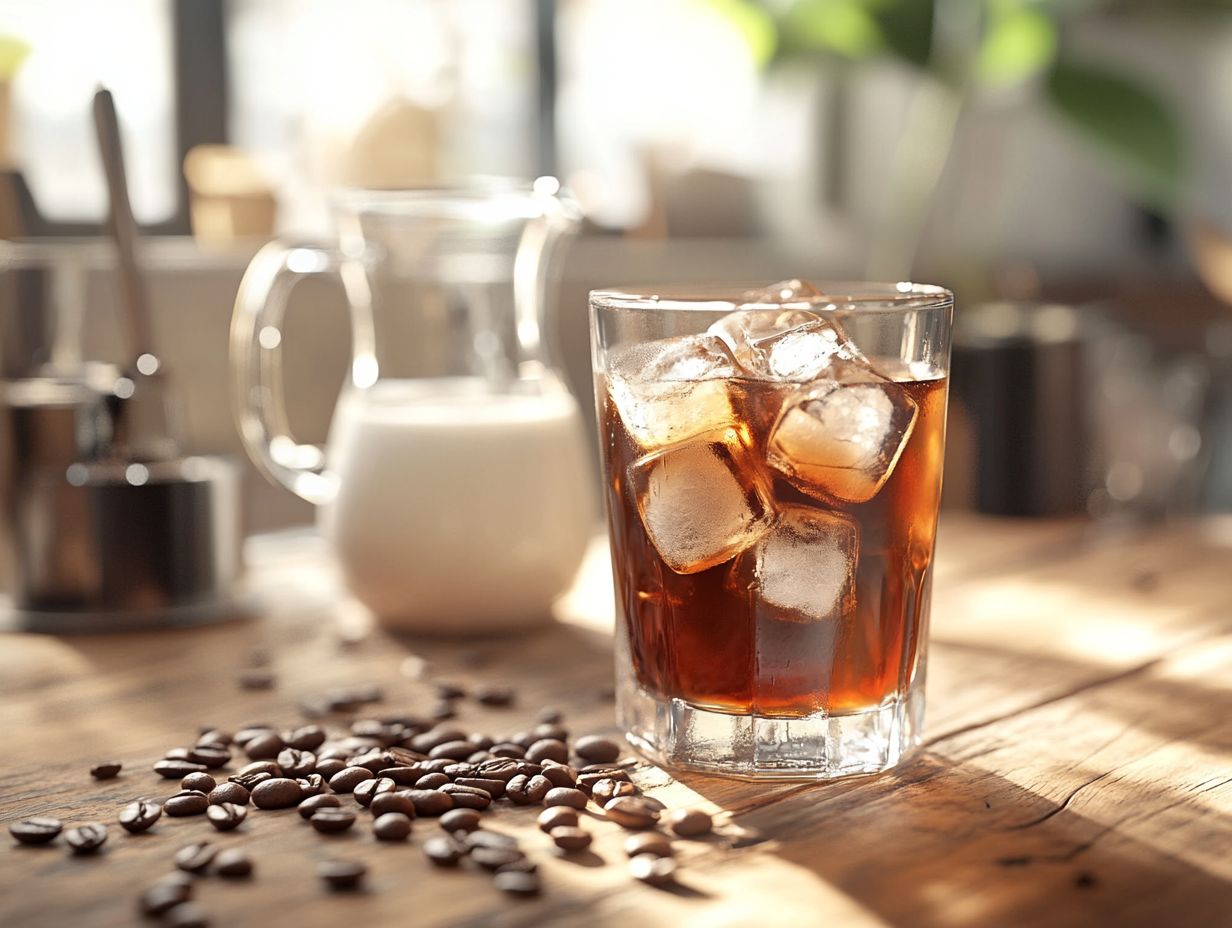
- Cold brew, iced coffee, Japanese iced coffee, nitro cold brew, and flash brew are all popular brewing techniques for cold coffee, each providing distinct coffee tasting experiences.
- The best brewing technique for cold coffee depends on factors such as flavor, caffeine content, convenience, time, cost, and personal coffee preferences.
- Cold brew is known for its smooth and rich flavor, while flash brew is quick and convenient. Iced coffee has a lighter flavor, and Japanese iced coffee combines the best of both worlds. Nitro cold brew is creamy and has a high caffeine content, but may not be as accessible or cost-effective.
Explore Popular Brewing Techniques for Cold Coffee
Cold coffee has become a favorite among coffee enthusiasts, largely because of its refreshing taste and the multitude of brewing techniques that cater to a range of preferences. Whether you enjoy the bold flavor of cold brew created through immersion brewing or the vibrant notes of iced coffee made with a quick pour-over, each method brings its own distinctive qualities that resonate with coffee lovers.
The Japanese brewing technique has also found a special place for those who desire a premium coffee experience. By understanding these various brewing methods, you can enhance your coffee tasting journey and choose the approach that best suits your palate.
Whether it’s the fruity tasting profiles of Ethiopian beans or the nutty undertones of Brazilian beans, each coffee extraction method offers unique coffee tasting notes.
1. Cold Brew
Cold brew is an intriguing method of preparing coffee where you steep coffee grounds in cold water for an extended period, typically between 12 to 24 hours. The result? A smooth and rich cold brew concentrate that you can enjoy in various forms whether diluted with milk and sugar or served straight over ice for a truly refreshing experience. This method has gained popularity among coffee professionals and beginners alike.
To craft the perfect cold brew, aim for a coffee-to-water ratio of around 1:4, though feel free to adjust this to suit your taste preferences. It s crucial to use coarsely ground coffee to avoid over-extraction, which can lead to an unpleasant bitterness. Utilizing a cold brew kit or system can simplify the brewing process, ensuring consistent results and making it easier for you to achieve your desired flavor profile.
Don’t hesitate to experiment with different coffee beans to elevate your cold brew experience. Ethiopian beans, for instance, bring delightful fruity notes, while Brazilian beans often contribute a nutty and chocolatey flavor. These variations add a delightful complexity to your final brew. Consider trying a DIY cold brew recipe or using a cold brew system like the Toddy Cold Brew System or the Hario Mizudashi Coffee Pot for consistent results.
Try brewing your own cold coffee at home and share your favorite methods with us!
What is the Cold Brew Method?
The cold brew method is a delightful method where coffee grounds soak in water. You steep coarsely ground coffee in cold or room-temperature water for an extended period. This lets the coffee flavors develop slowly, resulting in a concentrated brew that you can savor hot or cold.
Cold-brewed coffee is a favorite among coffee enthusiasts for its smooth, mellow profile and versatile uses. Typically, this process requires anywhere from 12 to 24 hours. That coarse grind is essential for extracting the perfect balance of flavors without inviting bitterness to the party.
Unlike traditional brewing methods that rush the extraction with heat, cold brewing gently teases out maximum flavor from the grounds, maintaining a smooth, mellow profile.
Using a coffee strainer, you can effectively separate the coarse particles from the liquid, ensuring a clean finish. This method enhances the natural sweetness of the coffee and minimizes acidity, creating a refreshing beverage that’s perfect for warm weather or that much-needed afternoon pick-me-up.
For an even smoother experience, some coffee shops and coffee makers offer ready-made cold brew options.
What are the Pros and Cons of Cold Brew?
Cold brew coffee has captured the hearts of many coffee enthusiasts with its smooth, low-acidity flavor profile, but it s not without its quirks. You ll find that it demands a longer brewing time and specific equipment, like a cold brew kit or a coffee grinder for coarse grounds, to achieve that perfect cup.
What draws you to cold brew is its rich, mellow taste, often described as having delightful hints of chocolate and caramel. This makes it an ideal choice for those who are sensitive to acidity. Its versatility lets you enjoy it straight or use it as a base for an array of coffee creations, including cocktails or iced lattes.
However, be prepared for a commitment, as the brewing process can take anywhere from 12 to 24 hours, so planning ahead is essential. Plus, the requirement for a coarser grind and a specialized cold brew maker like the Asobu Cold Brewer might be a turn-off for some home brewers.
Still, for those who truly appreciate a smooth and refreshing cup, these minor inconveniences are a small price to pay for the experience.
Iced Coffee
Iced coffee is the perfect way to beat the heat! Imagine freshly brewed coffee, chilled to perfection, and served over ice, often enhanced with a splash of milk and a touch of sugar or vanilla syrup. This combination creates a refreshing drink that coffee enthusiasts can indulge in at any time of day. Iced coffee season is the perfect time to explore different coffee techniques and flavors.
The enchantment of iced coffee begins with the brewing process. Various traditional methods can significantly elevate your iced coffee experience. For example, hot brewing using freshly ground beans whether you prefer light or dark roasts imparts a unique character and aroma that sets the stage for a delightful drink.
Once brewed, you can swiftly cool your coffee by pouring it over ice or into a chilled container, preserving those rich flavors.
Choosing the right type of bean and brewing method, whether it s a French press, drip, or pour-over, plays a vital role in the final taste. Each sip becomes a delightful encounter, allowing you to appreciate the intricate nuances of your carefully crafted iced coffee.
So grab your favorite beans and explore the world of iced coffee today!
What is the Iced Coffee Method?
The iced coffee method is quite straightforward: you brew hot coffee using your trusty coffee maker or a pour-over coffee maker. Then, pour it over ice to chill. It s a quick and convenient way to indulge in a refreshing cold coffee.
Fresh coffee grounds are essential for achieving the best flavor in this method. But why stop there? There are several variations you can explore to elevate both the flavor and the overall experience.
For example, brewing coffee directly over ice can produce a bolder taste. The immediate chilling captures the coffee s natural oils and aromas beautifully. Coffee reviews often highlight these nuances, offering insights into the best brewing practices.
You might also brew a double-strength batch in advance, allowing it to cool to room temperature before refrigerating. This way, you ll ensure that the final product remains flavorful without the worry of dilution, which means making something weaker by mixing it with water, from melting ice.
Don’t overlook the quality of your coffee grounds. Freshly ground beans can significantly enhance the richness and complexity of your iced coffee. By employing the right brewing techniques and choosing high-quality ingredients, you can transform your iced coffee experience into a delightful ritual, rather than just a quick refreshment.
Coffee professionals emphasize the importance of using fresh, high-quality beans for the best results.
What are the Pros and Cons of Iced Coffee?
While iced coffee offers an enticing and convenient beverage choice, it comes with its own set of advantages and drawbacks. You might notice that if the ice melts too quickly, it can dilute the rich coffee flavor, impacting your overall taste experience.
Iced coffee is a wonderfully refreshing option, especially during those warm days when you’re yearning for something cold and invigorating. Its appeal is further enhanced by the ease of preparation; with just a few simple steps, you can create a delightful cup at home or easily find it at your favorite caf .
To truly savor the rich flavors of iced coffee, it’s essential to use high-quality coffee beans. Opting for subpar beans can lead to a lackluster experience that misses the depth and vibrancy, diminishing the invigorating qualities that make this drink a beloved choice among coffee aficionados.
3. Japanese Iced Coffee
Japanese iced coffee masterfully marries the precision of pour-over brewing with the invigorating qualities of iced coffee. Here, hot coffee is brewed directly over ice, resulting in an intricate flavor profile that delivers a rich coffee experience and captures the essence of both techniques.
This method is highly regarded by coffee enthusiasts and recommended by experts like Erin McCarthy and coffee specialty sites like Serious Eats. This approach distinguishes itself from traditional iced coffee, which typically involves brewing a full pot and then chilling it.
By brewing directly onto ice, the Japanese technique rapidly cools the coffee, preserving essential flavors and aromas that would otherwise fade during the cooling process. Coffee professionals often compare this to other techniques to highlight its unique benefits.
It s imperative to use high-quality coffee grounds. The freshness and roast profile play a pivotal role in shaping the taste of your final cup. As the hot water cascades through the grounds, it extracts distinct notes that meld beautifully, creating a vibrant and aromatic beverage.
This approach showcases the meticulous attention to detail and quality that defines an exceptional coffee experience. Don’t miss out on the chance to elevate your iced coffee game!
What is the Japanese Iced Coffee Method?
The Japanese iced coffee method is an artful approach that involves brewing hot coffee directly over ice using a precise pour-over technique. This method not only cools the brew instantly but also preserves the nuanced flavor notes and aromatic qualities, resulting in an impeccably balanced iced coffee. This Japanese method showcases a distinctive coffee flavor that appeals to many coffee lovers.
To master this technique, you’ll need a few essential tools, including:
- A coffee strainer for perfect coffee extraction
- A high-quality pour-over dripper
- Freshly ground coffee
Aim for an ideal coffee-to-water ratio of about 1:15, which allows the rich flavors to shine without being diluted by the ice. When you pour hot water over the coffee grounds in a measured, slow manner, this technique extracts vibrant flavors, delivering a far more dynamically taste profile than traditional methods. Coffee professionals often recommend this to achieve the best cold coffee.
The immediate cooling effect prevents any unwelcome bitterness or acidity, making this method a beloved choice among coffee enthusiasts seeking a refreshing yet flavorful iced beverage.
What are the Pros and Cons of Japanese Iced Coffee?
Brewing Methods
The Japanese iced coffee method presents a distinctive approach to brewing that many coffee aficionados appreciate for its rich flavor and aroma; however, it does come with its own set of challenges, requiring precision and specific equipment such as a high-quality coffee maker and a coffee strainer to achieve the perfect cup.
One of the key advantages of this brewing technique is its remarkable ability to showcase the subtle flavors of freshly ground coffee beans, resulting in a refreshing and vibrant cup that often surpasses traditional iced coffee. The rapid brewing process pouring hot water over ice captures the essential oils and aromas of the coffee, leading to a taste experience that is truly exceptional. Coffee tasting with this method often reveals a more nuanced flavor profile.
However, it’s crucial to acknowledge the complexities that can arise. If this method isn’t executed with meticulous care, you might find the results to be inconsistent, with potential pitfalls in strength and flavor balance that could diminish the overall experience. This is why coffee brewing methods like this require a good understanding of coffee techniques and the right coffee equipment.
4. Nitro Cold Brew
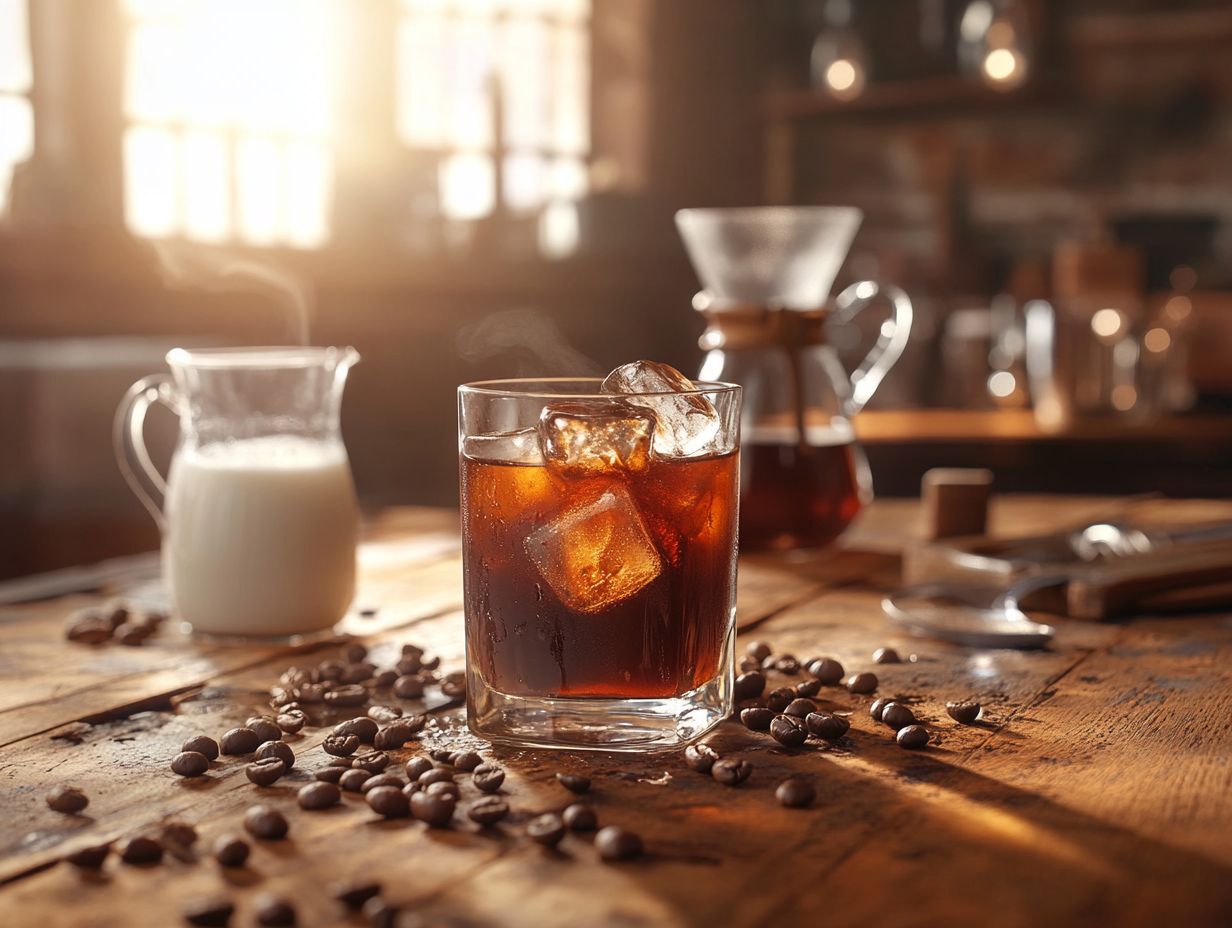
Nitro cold brew is the must-try coffee sensation you ve been hearing about, captivating coffee enthusiasts with its unique texture and flavor. When nitrogen gas is infused into cold brew coffee, the result is a creamy mouthfeel coupled with a rich, frothy appearance that s hard to resist.
To prepare this delightful drink, you ll start by cold brewing coarse coffee grounds for an extended period typically anywhere from 12 to 24 hours before transferring the concentrated brew into a keg. Once that s done, nitrogen is introduced under pressure, creating a mesmerizing cascade effect as it s poured, much like a draft beer. This infusion not only elevates the drink s silky smoothness but also brings out the natural sweetness of the coffee, distinguishing it from traditional cold brew, which can sometimes veer into bitter territory.
The surge in nitro cold brew s popularity at coffee shops like Caribou Coffee is no accident; it s all about the eye-catching visual presentation and the refreshing experience it delivers. Whether you re a casual drinker or a dedicated coffee aficionado, this beverage quickly becomes a favorite.
What is Nitro Cold Brew?
Nitro cold brew is a sophisticated coffee beverage crafted by infusing cold brew coffee with nitrogen gas. This enhances its texture and flavor to create a creamy, smooth drink that is often served on tap, similar to draft beer. This technique has gained popularity through coffee reviews from experts like Erin McCarthy and Tracie from Serious Eats.
The journey to this delightful concoction begins with steeping coarsely ground coffee beans in cold water for an extended period anywhere from 12 to 24 hours. This method allows the flavors to fully extract without the bitterness typically associated with hot brewing techniques.
Once your cold brew reaches perfection, nitrogen is infused under pressure, transforming the drink at a molecular level. This infusion creates tiny bubbles that elevate its visual charm and contribute to a velvety mouthfeel and a rich, frothy head that invites you to take a sip.
While nitro cold brew promises a delightful drinking experience, it comes with its challenges. You will need special tools and careful control over nitrogen levels to avoid issues like over-carbonation or undesirable off-flavors. Coffee enthusiasts who love a rich coffee experience will find it worth the effort.
What are the Pros and Cons of Nitro Cold Brew?
Nitro cold brew presents a distinctive sensory experience that many coffee enthusiasts adore for its smoothness and creamy texture. However, it does come with a few trade-offs, including the need for special tools and the potential costs involved in its preparation.
This popular beverage captivates you not just with its rich, velvety mouthfeel, but also with the visually striking cascade effect produced by the nitrogen infusion. This makes it a stunning choice for both cafes and home brewers. Nitro cold brew is often featured in coffee tasting events due to its unique characteristics.
The financial investment required is a consideration; quality infusers and kegs can be quite expensive. Without these tools, replicating its signature characteristics at home can be challenging.
The time and effort needed to master the brewing process may feel daunting, especially for those in search of a quick caffeine fix. This can ultimately limit its accessibility for everyday coffee lovers. Consider investing in a cold brew kit or system for a more manageable experience.
Flash Brew
Flash brew is an innovative brewing technique that allows you to combine the immediate cooling of hot coffee with the refreshing qualities of iced coffee. This method provides a quick and efficient way to enjoy a flavorful cold beverage without compromising on quality.
Unlike traditional brewing methods, which require hot coffee to cool down over time often leading to a diluted flavor profile flash brew brews coffee directly onto ice. This approach halts the brewing process and preserves the coffee’s vibrant aroma and natural sweetness.
As a coffee enthusiast, you ll appreciate how this technique delivers a remarkably complex taste experience, showcasing bright acidity and rich notes that are often lost in slower cooling methods. For those who value convenience without sacrificing quality, flash brew offers an enticing option, perfectly suited for busy lifestyles while ensuring that each sip brims with freshness. Coffee professionals like Erin McCarthy from Counter Culture Coffee often recommend this method for its quick and efficient brewing process.
Cold Brew Recipe
Flash brewing is a method that allows you to create a concentrated hot coffee that s swiftly cooled by pouring it over ice. This process delivers a rich flavor with a refreshing finish, making it perfect for coffee enthusiasts who appreciate both speed and taste.
To master this innovative brewing technique, you ll typically need a pour-over dripper, a scale, and a thermometer to ensure precision. A good coffee maker and coffee grinder can also help. As you pour hot water over the coffee grounds, it extracts essential oils and compounds, resulting in a robust concentrate. The moment you introduce ice, you effectively pause the extraction process, preserving the bright flavors and aromatic qualities of the coffee. This method is often highlighted in coffee reviews for its efficiency.
This rapid cooling not only enhances the clarity of flavors but also provides a delightful contrast in temperature, enabling you to fully savor the coffee’s nuances without the bitterness often found in traditional cold brews. Ultimately, this experience transforms into something invigorating and complex, appealing to those who truly appreciate a nuanced coffee profile.
What are the Pros and Cons of Flash Brew?
While flash brewing offers you a quick and flavorful coffee experience, it can also present some challenges in achieving consistent results. You ll discover that mastering this method is exciting and rewarding! This approach, which combines brewing and cooling processes to create a vibrant cup in a fraction of the time, is especially appealing for those of you with busy lives who still crave a quality beverage.
You ll appreciate how it enhances flavor profiles, allowing the unique characteristics of different beans to shine through. However, the trade-off is a steep learning curve as you master various variables, like water temperature and brew time. If not executed properly, you could end up with frustrating results.
As with any brewing method, practice and experimentation are essential for honing your skills and achieving that perfect cup. Blind tasting can be a useful technique to understand different coffee flavors and preferences better.
Which Brewing Technique is the Best for Cold Coffee?
Coffee Methods
Preparation Techniques
Selecting the ideal brewing technique for your cold coffee is a highly personal endeavor, shaped by your unique preferences and aspirations. Each method be it cold brew, iced coffee, Japanese iced coffee, or nitro cold brew delivers its own distinct flavor profiles, varying caffeine levels, and levels of convenience. For a DIY cold brew experience, consider using a Toddy Cold Brew System or a Hario Mizudashi Coffee Pot.
These nuances cater to the diverse tastes of coffee enthusiasts like yourself, ensuring that you find the perfect cup to match your desires.
Factors to Consider when Choosing a Brewing Technique
When selecting a brewing technique for cold coffee, several important factors come into play, including your personal taste preferences, the flavor profiles you desire, and the amount of time and effort you’re willing to devote to coffee preparation.
Beyond these considerations, the complexity of flavor intensity is crucial. Some methods yield a robust taste, while others offer a milder cup that might better suit your palate. Acidity levels are also significant; if you’re drawn to a brighter, more vibrant coffee experience, you may want to explore brewing styles that emphasize these characteristics.
Preparation time will undoubtedly influence your decisions as well. If you lead a busy lifestyle, you might gravitate toward quicker methods, while true coffee aficionados may find joy in the intricacies of more elaborate processes. Lastly, consider the equipment you have on hand. Not everyone has access to specialized devices, so the convenience of using everyday kitchen tools can be a decisive factor in finding your perfect brew.
Now that you’re equipped with insights on various brewing techniques, why not try your hand at flash brewing or explore other methods? Share your experiences with cold coffee and discover the flavors that resonate with you!
1. Flavor
Flavor is key when choosing a cold coffee brewing technique. The method you select can dramatically shape the taste and overall experience of your coffee.
Take cold brew, for example. The longer steeping time yields a mellow, sweet profile with delightful chocolatey undertones, perfectly suited for those who lean towards a smoother flavor.
In contrast, iced pour-over techniques can elevate the bright acidity and floral notes of specialty beans, resulting in a more vibrant and refreshing cup.
Don t overlook the importance of the coffee beans themselves. Opting for single-origin beans from Ethiopia might introduce you to fruity, berry-like flavors, while a Brazilian blend offers rich, nutty, and caramel characteristics.
Ultimately, diving into different brewing methods and bean selections lets you discover your ideal flavor match in every cup.
2. Caffeine Content

Caffeine content plays an important part in your selection of cold coffee brewing methods. Various techniques yield different levels of caffeine concentration in your final cup.
This variation largely depends on the specific brewing method you choose. For instance, cold brew stands out with its extended brewing time and coarser coffee grounds, allowing for a smoother extraction that typically results in higher caffeine levels.
Iced coffee is brewed hot and then chilled, which can lead to a lower caffeine concentration. This largely hinges on how long you brew it and the coarseness of the grind.
Then there s nitro cold brew, which takes your coffee experience to new heights. By combining the high caffeine extraction of cold brew with nitrogen infusion, it creates a smooth, creamy feel while still delivering a substantial caffeine kick.
Understanding these subtle nuances in preparation can significantly enhance your enjoyment of cold coffee, ensuring you savor every sip to its fullest potential.
3. Convenience
Convenience plays an important part in your cold coffee brewing experience. Some methods demand more time and equipment than others, ultimately influencing your choice of brewing technique.
If you lead a busy lifestyle, it s essential to find a brewing method that integrates seamlessly into your morning routine without adding any extra stress. Many people seek options that fit effortlessly into their schedules while still delivering that rich, satisfying flavor they crave.
Take the traditional cold brew, for instance. It requires several hours of steeping and special equipment, which can be a turnoff for those always on the go.
In contrast, quicker alternatives, like instant coffee or a French press, offer a fast preparation process that suits those hectic mornings perfectly.
Understanding the convenience factor of each technique is crucial if you want to savor a delicious cup of cold coffee without sacrificing your precious time.
4. Time
The time required to brew coffee can vary significantly across different cold coffee methods. This is crucial for anyone seeking a quick yet flavorful caffeine fix.
Take cold brew, for example. It typically requires a steeping period of 12 to 24 hours, rewarding you with a rich, smooth flavor profile and low acidity.
On the other hand, iced coffee, made by brewing hot coffee and then chilling it, can be ready in just a few minutes. While it offers a more traditional coffee taste, it often ends up diluted by ice.
Japanese iced coffee presents a unique approach. It brews directly onto ice and takes about the same amount of time as regular coffee. This method yields a vibrant, aromatic cup that s hard to resist.
Then there’s nitro cold brew, infused with nitrogen for a creamy texture, which also demands a long cold brew process, making it less convenient if you’re in a hurry.
Flash brew strikes a balance between the two, brewing hot coffee and quickly cooling it down. This results in a bright, flavorful cup that s ready within minutes.
Ultimately, each brewing method not only impacts the time you need to invest but also influences the taste and overall experience of your coffee ritual.
5. Cost
Cost is a key factor to consider when selecting a cold coffee brewing method. Some techniques may require specific equipment or ingredients that can impact your overall budget for coffee preparation.
If you’re leaning towards the traditional cold brew process, you might need to invest in a dedicated brewing system or specialty jars. If the Japanese iced coffee technique interests you, quality pour-over equipment may also stretch your budget a bit. To explore more about different methods, check out the top brewing techniques for specialty coffee.
Don’t forget about your choice of coffee beans. Opting for premium, freshly roasted beans can elevate your flavor experience but might also increase your costs. Other elements like filters, water quality, and even the ice you use can contribute to your expenses.
Take the time to weigh the benefits of each method to find your perfect cold coffee experience while considering your budget constraints.
Frequently Asked Questions
What are the best brewing techniques for cold coffee?
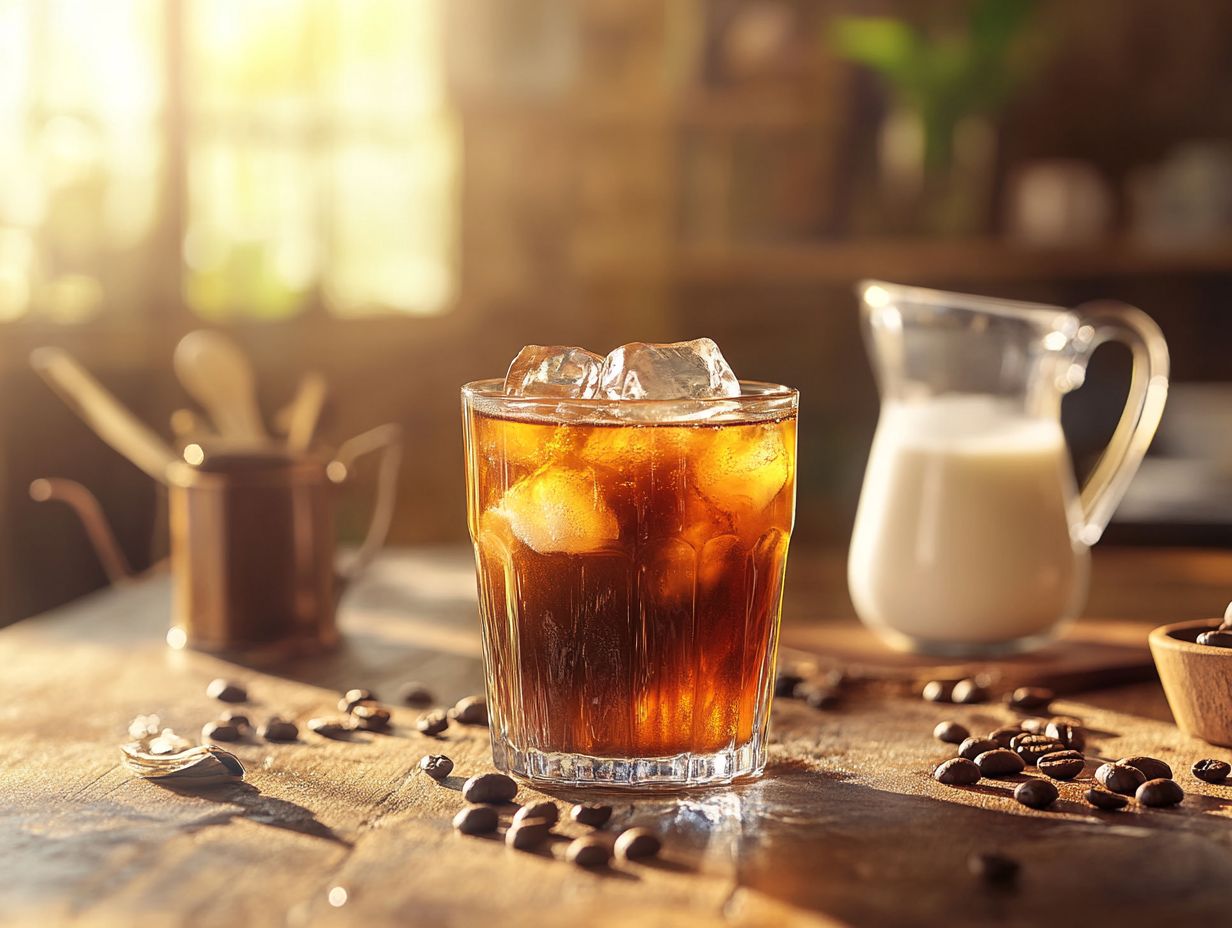
The best brewing techniques for cold coffee include cold brew, iced pour over, and Japanese iced coffee methods.
How do I make cold brew coffee?
To make cold brew coffee, combine coarsely ground coffee beans and filtered water in a container. Let it sit in the fridge for 12-24 hours, then strain and enjoy.
What is the difference between cold brew and iced coffee?
The main difference between cold brew and iced coffee lies in the brewing method. Cold brew involves steeping coffee grounds in cold water for a long period, while iced coffee is brewed hot and then poured over ice.
What is the Japanese iced coffee method?
The Japanese iced coffee method brews hot coffee directly onto ice, rapidly cooling it and preserving its flavors.
Why is cold brew coffee popular?
Cold brew coffee has gained popularity for its smooth, less acidic taste and the ability to be easily customized with different flavorings and milk options.
What are some tips for brewing the best cold coffee?
Some tips for brewing the best cold coffee include using high-quality, freshly roasted beans, experimenting with different coffee-to-water ratios, and using a coarse grind to prevent over-extraction.
Try out these methods and share your own experiences with cold coffee brewing!


